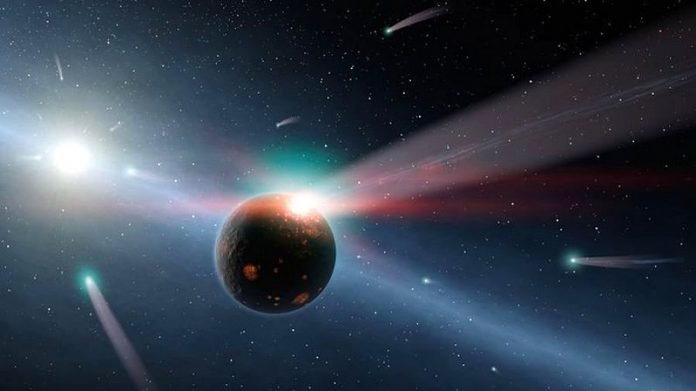
The early solar system was an especially violent place.
The terrestrial planets (Mercury, Venus, Earth, and Mars) likely formed by suffering countless collisions between planetesimals.
But the material left over from all those collisions should have remained in orbit around the sun, where it would’ve eventually found itself in the asteroid belt. But the belt contains no such record of that process.
What happened to the missing pieces of the solar system?
Two researchers from Arizona State University’s School of Earth and Space Exploration, former NewSpace Postdoctoral Fellow Travis Gabriel and doctoral student Harrison Allen-Sutter, conducted extensive computer simulations of the early solar system to track what happened to the debris when planetesimals collided.
“Most researchers focus on the direct effects of impacts, but the nature of the debris has been underexplored,” Allen-Sutter said.
Gabriel and Allen-Sutter discovered that the energies released during a massive collision were sufficient to vaporize the debris.
So rather than sending big chunks flying wide, the leftovers were atomized. That has could more easily escape the solar system, never to be seen again.
Their work has been published in the Astrophysical Journal Letters.
“It has long since been understood that numerous large collisions are required to form Mercury, Venus, Earth, the moon and perhaps Mars,” said Gabriel, who is the principal investigator of this project.
“But the tremendous amount of impact debris expected from this process is not observed in the asteroid belt, so it has always been a paradoxical situation.”
This new insight also helps us understand the formation and early evolution of the moon.
“After forming from debris bound to the Earth, the moon would have also been bombarded by the ejected material that orbits the sun over the first hundred million years or so of the moon’s existence,” Gabriel said.
“If this debris was solid, it could compromise or strongly influence the moon’s early formation, especially if the collision was violent. If the material was in gas form, however, the debris may not have influenced the early moon at all.”
Since all records of these collisions appear to have been lost, Gabriel and Allen-Sutter hope to look next to other solar systems.
“There is growing evidence that certain telescope observations may have directly imaged giant impact debris around other stars,” Gabriel said.
“Since we cannot go back in time to observe the collisions in our solar system, these astrophysical observations of other worlds are a natural laboratory for us to test and explore our theory.”
Written by Paul M. Sutter.
Source: Universe Today.



